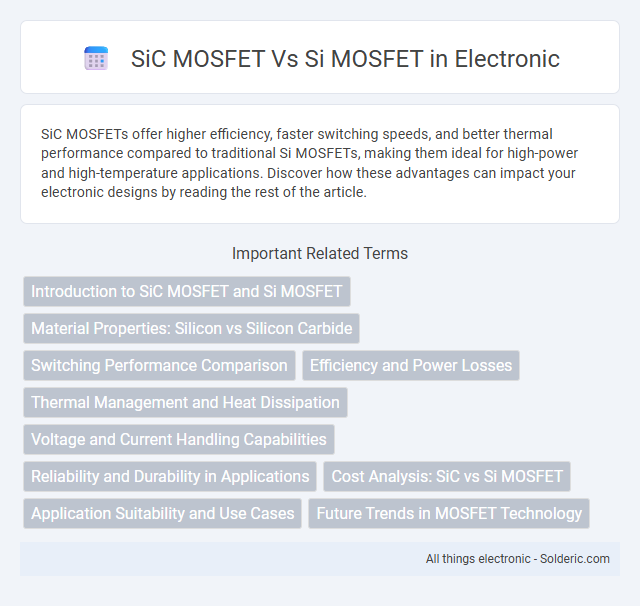SiC MOSFETs offer higher efficiency, faster switching speeds, and better thermal performance compared to traditional Si MOSFETs, making them ideal for high-power and high-temperature applications. Discover how these advantages can impact your electronic designs by reading the rest of the article.
Comparison Table
| Feature | SiC MOSFET | Si MOSFET |
|---|---|---|
| Material | Silicon Carbide (SiC) | Silicon (Si) |
| Switching Speed | High, >10x faster | Moderate |
| Operating Temperature | Up to 200-300degC | Up to 150degC |
| Voltage Rating | Up to 1200V and beyond | Typically up to 600V |
| On-Resistance (R_DS(on)) | Lower, improving efficiency | Higher |
| Thermal Conductivity | 3.5 W/cm*K (High) | 1.5 W/cm*K (Lower) |
| Efficiency | Higher, reduces losses | Lower |
| Cost | Higher | Lower |
| Applications | High-power, high-frequency, EV and solar inverters | General purpose, low-power electronics |
Introduction to SiC MOSFET and Si MOSFET
SiC MOSFETs utilize silicon carbide semiconductor material, offering higher breakdown voltage, faster switching speeds, and greater thermal conductivity compared to traditional Si MOSFETs made from silicon. These properties enable SiC MOSFETs to operate efficiently at high temperatures and voltages, making them ideal for applications in electric vehicles, renewable energy systems, and power supplies. In contrast, Si MOSFETs, while mature and cost-effective, have limitations in high-power, high-frequency environments due to lower electron mobility and thermal performance.
Material Properties: Silicon vs Silicon Carbide
Silicon Carbide (SiC) MOSFETs offer superior material properties compared to traditional Silicon (Si) MOSFETs, featuring a wider bandgap of approximately 3.26 eV versus 1.12 eV for silicon, which enables higher breakdown voltage and improved thermal stability. SiC's higher thermal conductivity (~3.7 W/cm*K) allows for better heat dissipation, making it ideal for high-temperature and high-power applications. Your power electronics designs benefit from SiC MOSFETs' efficient performance in harsh environments where silicon devices would typically degrade.
Switching Performance Comparison
SiC MOSFETs exhibit superior switching performance compared to Si MOSFETs, with faster switching speeds and lower switching losses due to their wide bandgap material properties. This results in higher efficiency and reduced thermal management requirements in power electronic applications. Your systems benefit from improved transient response and lower conduction losses when using SiC MOSFET technology over conventional silicon devices.
Efficiency and Power Losses
SiC MOSFETs offer significantly higher efficiency than Si MOSFETs due to their lower on-resistance and faster switching speeds, which reduce conduction and switching losses in power electronics applications. Your systems benefit from SiC MOSFETs' ability to operate at higher temperatures and voltages without degrading performance, leading to improved thermal management and reliability. This results in lower overall power losses and enhanced energy savings compared to conventional silicon-based MOSFETs.
Thermal Management and Heat Dissipation
SiC MOSFETs exhibit superior thermal management and heat dissipation compared to Si MOSFETs due to their wide bandgap properties, allowing operation at higher temperatures up to 175degC or more. The higher thermal conductivity of silicon carbide facilitates efficient heat transfer, reducing the need for extensive cooling systems and enhancing reliability in high-power applications. In contrast, Si MOSFETs generally require more robust heat sinks to manage thermal stress, limiting their performance in elevated temperature environments.
Voltage and Current Handling Capabilities
SiC MOSFETs exhibit superior voltage handling capabilities, often rated above 1200V, compared to Si MOSFETs which typically max out around 600V to 900V. Their wide bandgap material allows SiC devices to manage higher current densities with lower on-resistance, enhancing efficiency and thermal performance. Your power applications benefit from SiC MOSFETs' ability to operate reliably under higher voltages and currents, leading to more compact and robust designs.
Reliability and Durability in Applications
SiC MOSFETs demonstrate superior reliability and durability compared to Si MOSFETs due to their high thermal conductivity and wide bandgap properties, enabling operation at higher temperatures and voltages with reduced risk of failure. Your application benefits from SiC MOSFETs' enhanced resistance to thermal runaway and avalanche conditions, ensuring longer device lifespans under harsh environments. This increased ruggedness makes SiC MOSFETs ideal for demanding applications such as electric vehicles, industrial motor drives, and renewable energy systems where sustained performance and durability are critical.
Cost Analysis: SiC vs Si MOSFET
SiC MOSFETs typically have a higher initial cost compared to Si MOSFETs due to the complex manufacturing processes and advanced materials used. However, SiC devices offer better efficiency, higher temperature operation, and longer lifespan, which can reduce overall system costs and improve reliability in high-power applications. Evaluating Your total cost of ownership reveals SiC MOSFETs often deliver better value despite the premium upfront investment.
Application Suitability and Use Cases
SiC MOSFETs excel in high-power and high-frequency applications such as electric vehicles, renewable energy systems, and industrial motor drives due to their superior thermal conductivity and higher switching speeds compared to Si MOSFETs. Si MOSFETs remain preferable for low-voltage, cost-sensitive applications like consumer electronics and basic power supplies because of their mature manufacturing processes and lower initial costs. The choice between SiC and Si MOSFETs depends largely on the application's requirements for efficiency, thermal performance, and operating voltage ranges.
Future Trends in MOSFET Technology
SiC MOSFETs are rapidly emerging as the preferred choice for high-efficiency power electronics due to their superior thermal conductivity, higher breakdown voltage, and faster switching speeds compared to traditional Si MOSFETs. The future of MOSFET technology is leaning towards wide bandgap semiconductors like SiC, which enable smaller, lighter, and more energy-efficient power devices critical for electric vehicles, renewable energy systems, and advanced industrial applications. Your adoption of SiC MOSFETs can significantly enhance performance and reliability in next-generation power electronics.
SiC MOSFET vs Si MOSFET Infographic

 solderic.com
solderic.com